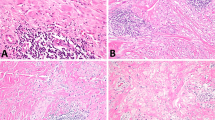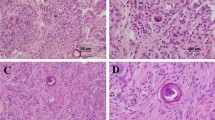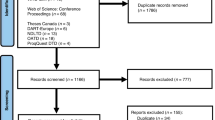Abstract
Rhabdoid tumor predisposition syndrome type-1 (RTPS1) is characterized by germline pathogenic variants in SMARCB1 and development of INI1-deficient rhabdoid tumors in early childhood. Due to its poor prognosis, the risk of subsequent tumor development and the impact of surveillance at later ages are poorly understood. We retrospectively reviewed individuals referred to the Cancer Genetics Program at The Hospital for Sick Children for SMARCB1 genetic testing and/or surveillance for RTPS1. In addition, to explore characteristics of late-onset tumors in RTPS1, a literature review was conducted. Of eighty-three individuals (55 probands and 28 family members), 12 probands and 4 family members were genetically confirmed with RTPS1. Four pediatric probands with RTPS1 underwent surveillance. An additional three individuals, including one patient with 22q11.2 distal deletion without history of tumor, one patient with negative genetic testing results but clinically diagnosed with RTPS1, and one sibling identified through cascade testing, underwent surveillance. Three patients with RTPS1 developed tumors between the ages of 9 and 17, including malignant rhabdoid tumors (N = 3), schwannomas (N = 4), and epithelioid malignant peripheral nerve sheath tumor (N = 1). Three of these lesions were asymptomatically detected by surveillance. A literature review revealed 17 individuals with RTPS1 who developed INI1-deficient tumors after age five. Individuals with RTPS1 remain at elevated risk for developing INI1-deficient tumors after the peak age of rhabdoid tumor in early childhood. Extension of surveillance beyond 5 years of age could lead to improved survival and reduced morbidity for these patients, and prospective evaluation of revised approaches will be important.
This is a preview of subscription content, access via your institution
Access options
Subscribe to this journal
Receive 12 print issues and online access
$259.00 per year
only $21.58 per issue
Buy this article
- Purchase on SpringerLink
- Instant access to full article PDF
Prices may be subject to local taxes which are calculated during checkout

Similar content being viewed by others
Data availability
Data available on request from the authors
References
Pawel BR. SMARCB1-deficient Tumors of Childhood: A Practical Guide. Pediatr Dev Pathol. 2018;21:6–28.
Schaefer I-M, Hornick JL. SWI/SNF complex-deficient soft tissue neoplasms: An update. Semin Diagn Pathol. 2021;38:222–31.
Dermawan JK, Singer S, Tap WD, Nacev BA, Chi P, Wexler LH, et al. The genetic landscape of SMARCB1 alterations in SMARCB1-deficient spectrum of mesenchymal neoplasms. Mod Pathol. 2022;35:1900–9.
Johann PD, Hovestadt V, Thomas C, Jeibmann A, Heß K, Bens S, et al. Cribriform neuroepithelial tumor: molecular characterization of a SMARCB1-deficient non-rhabdoid tumor with favorable long-term outcome. Brain Pathol. 2017;27:411–8.
Thomas C, Wefers A, Bens S, Nemes K, Agaimy A, Oyen F, et al. Desmoplastic myxoid tumor, SMARCB1-mutant: clinical, histopathological and molecular characterization of a pineal region tumor encountered in adolescents and adults. Acta Neuropathol. 2020;139:277–86.
Duan Z, Yao K, Yang S, Qu Y, Ren M, Zhang Y, et al. Primary adult sellar SMARCB1/INI1-deficient tumor represents a subtype of atypical teratoid/rhabdoid tumor. Mod Pathol. 2022;35:1910–20.
Louis DN, Perry A, Wesseling P, Brat DJ, Cree IA, Figarella-Branger D, et al. The 2021 WHO Classification of Tumors of the Central Nervous System: a summary. Neuro Oncol. 2021;23:1231–51.
Smith MJ, Wallace AJ, Bowers NL, Eaton H, Evans DGR. SMARCB1 mutations in schwannomatosis and genotype correlations with rhabdoid tumors. Cancer Genet. 2014;207:373–8.
Evans DGR, Salvador H, Chang VY, Erez A, Voss SD, Druker H, et al. Cancer and Central Nervous System Tumor Surveillance in Pediatric Neurofibromatosis 2 and Related Disorders. Clin Cancer Res. 2017;23:e54–61.
Foulkes WD, Kamihara J, Evans DGR, Brugières L, Bourdeaut F, Molenaar JJ, et al. Cancer Surveillance in Gorlin Syndrome and Rhabdoid Tumor Predisposition Syndrome. Clin Cancer Res. 2017;23:e62–7.
Plotkin SR, Messiaen L, Legius E, Pancza P, Avery RA, Blakeley JO, et al. Updated diagnostic criteria and nomenclature for neurofibromatosis type 2 and schwannomatosis: An international consensus recommendation. Genet Med. 2022;24:1967–77.
Del Baldo G, Carta R, Alessi I, Merli P, Agolini E, Rinelli M, et al. Rhabdoid Tumor Predisposition Syndrome: From Clinical Suspicion to General Management. Front Oncol. 2021;11:586288.
Brennan B, Stiller C, Bourdeaut F. Extracranial rhabdoid tumours: what we have learned so far and future directions. Lancet Oncol. 2013;14:e329–36.
Frühwald MC, Nemes K, Boztug H, Cornips MCA, Evans DG, Farah R, et al. Current recommendations for clinical surveillance and genetic testing in rhabdoid tumor predisposition: a report from the SIOPE Host Genome Working Group. Fam Cancer. 2021;20:305–16.
Nemes K, Johann PD, Tüchert S, Melchior P, Vokuhl C, Siebert R, et al. Current and Emerging Therapeutic Approaches for Extracranial Malignant Rhabdoid Tumors. Cancer Manag Res. 2022;14:479–98.
Holsten T, Bens S, Oyen F, Nemes K, Hasselblatt M, Kordes U, et al. Germline variants in SMARCB1 and other members of the BAF chromatin-remodeling complex across human disease entities: a meta-analysis. Eur J Hum Genet. 2018;26:1083–93.
Belakhoua SM, Rodriguez FJ. Diagnostic Pathology of Tumors of Peripheral Nerve. Neurosurgery. 2021;88:443–56.
Eaton KW, Tooke LS, Wainwright LM, Judkins AR, Biegel JA. Spectrum of SMARCB1/INI1 mutations in familial and sporadic rhabdoid tumors. Pediatr Blood Cancer. 2011;56:7–15.
Reddy AT, Strother DR, Judkins AR, Burger PC, Pollack IF, Krailo MD, et al. Efficacy of High-Dose Chemotherapy and Three-Dimensional Conformal Radiation for Atypical Teratoid/Rhabdoid Tumor: A Report From the Children’s Oncology Group Trial ACNS0333. J Clin Oncol. 2020;38:1175–85.
Harris P, Taylor R, Thielke R, Payne J, Gonzalez N, Conde J. Research electronic data capture (REDCap) - A metadata-driven methodology and workflow process for providing translational research informatics support. J Biomed Inf. 2009;42:377–81.
Bhatt MD, Al-Karmi S, Druker H, Gupta A, Lu M, Malkin D, et al. Second rhabdoid tumor 8 years after treatment of atypical teratoid/rhabdoid tumor in a child with germline SMARCB1 mutation. Pediatr Blood Cancer. 2019;66:e27546.
Bourdeaut F, Lequin D, Brugières L, Reynaud S, Dufour C, Doz F, et al. Frequent hSNF5/INI1 germline mutations in patients with rhabdoid tumor. Clin Cancer Res. 2011;17:31–8.
Shirai R, Osumi T, Terashima K, Kiyotani C, Uchiyama M, Tsujimoto S, et al. High prevalence of SMARCB1 constitutional abnormalities including mosaicism in malignant rhabdoid tumors. Eur J Hum Genet. 2020;28:1124–8.
Forest F, David A, Arrufat S, Pierron G, Ranchere-Vince D, Stephan J-L, et al. Conventional chondrosarcoma in a survivor of rhabdoid tumor: enlarging the spectrum of tumors associated with SMARCB1 germline mutations. Am J Surg Pathol. 2012;36:1892–6.
Baker TG, Lyons MJ, Leddy L, Parham DM, Welsh CT. Epithelioid Sarcoma Arising in a Long-Term Survivor of an Atypical Teratoid/Rhabdoid Tumor in a Patient With Rhabdoid Tumor Predisposition Syndrome. Pediatr Dev Pathol. 2021;24:164–8.
Sévenet N, Sheridan E, Amram D, Schneider P, Handgretinger R, Delattre O. Constitutional mutations of the hSNF5/INI1 gene predispose to a variety of cancers. Am J Hum Genet. 1999;65:1342–8.
Fukushima H, Yamasaki K, Sakaida M, Tsujio N, Okuno T, Ishii N, et al. Rhabdoid tumor predisposition syndrome with renal tumor 10 years after brain tumor. Pathol Int. 2021;71:155–60.
Bosse KR, Shukla AR, Pawel B, Chikwava KR, Santi M, Tooke L, et al. Malignant rhabdoid tumor of the bladder and ganglioglioma in a 14 year-old male with a germline 22q11.2 deletion. Cancer Genet. 2014;207:415–9.
Swensen JJ, Keyser J, Coffin CM, Biegel JA, Viskochil DH, Williams MS. Familial occurrence of schwannomas and malignant rhabdoid tumour associated with a duplication in SMARCB1. J Med Genet. 2009;46:68–72.
Beddow RA, Smith M, Kidd A, Corbett R, Hunter AG. Diagnosis of distal 22q11.2 deletion syndrome in a patient with a teratoid/rhabdoid tumour. Eur J Med Genet. 2011;54:295–8.
Kehrer-Sawatzki H, Kordes U, Seiffert S, Summerer A, Hagel C, Schüller U, et al. Co-occurrence of schwannomatosis and rhabdoid tumor predisposition syndrome 1. Mol Genet Genom Med. 2018;6:627–37.
Ammerlaan ACJ, Ararou A, Houben MPWA, Baas F, Tijssen CC, Teepen JLJM, et al. Long-term survival and transmission of INI1-mutation via nonpenetrant males in a family with rhabdoid tumour predisposition syndrome. Br J Cancer. 2008;98:474–9.
Carter JM, O’Hara C, Dundas G, Gilchrist D, Collins MS, Eaton K, et al. Epithelioid malignant peripheral nerve sheath tumor arising in a schwannoma, in a patient with “neuroblastoma-like” schwannomatosis and a novel germline SMARCB1 mutation. Am J Surg Pathol. 2012;36:154–60.
Upadhyaya SA, McGee RB, Wilky BA, Broniscer A. Malignant progression of a peripheral nerve sheath tumor in the setting of rhabdoid tumor predisposition syndrome. Pediatr Blood Cancer. 2018;65:e27030.
Voisin MR, Ovenden C, Tsang DS, Gupta AA, Huang A, Gao AF, et al. Atypical Teratoid/Rhabdoid Sellar Tumor in an Adult with a Familial History of a Germline SMARCB1 Mutation: Case Report and Review of the Literature. World Neurosurg. 2019;127:336–45.
Teplick A, Kowalski M, Biegel JA, Nichols KE. Educational paper: screening in cancer predisposition syndromes: guidelines for the general pediatrician. Eur J Pediatr. 2011;170:285–94.
Malkin D, Nichols KE, Schiffman JD, Plon SE, Brodeur GM. The Future of Surveillance in the Context of Cancer Predisposition: Through the Murky Looking Glass. Clin Cancer Res. 2017;23:e133–7.
Al-Sarhani H, Gottumukkala RV, Grasparil ADS 2nd, Tung EL, Gee MS, et al. Screening of cancer predisposition syndromes. Pediatr Radio. 2022;52:401–17.
Evans DG, Mostaccioli S, Pang D, Fadzil O Connor M, Pittara M, Champollion N, et al. ERN GENTURIS clinical practice guidelines for the diagnosis, treatment, management and surveillance of people with schwannomatosis. Eur J Hum Genet. 2022;30:812–7.
Kehrer-Sawatzki H, Farschtschi S, Mautner V-F, Cooper DN. The molecular pathogenesis of schwannomatosis, a paradigm for the co-involvement of multiple tumour suppressor genes in tumorigenesis. Hum Genet. 2017;136:129–48.
Fagerberg CR, Graakjaer J, Heinl UD, Ousager LB, Dreyer I, Kirchhoff M, et al. Heart defects and other features of the 22q11 distal deletion syndrome. Eur J Med Genet. 2013;56:98–107.
Jackson EM, Shaikh TH, Gururangan S, Jones MC, Malkin D, Nikkel SM, et al. High-density single nucleotide polymorphism array analysis in patients with germline deletions of 22q11.2 and malignant rhabdoid tumor. Hum Genet. 2007;122:117–27.
Ben-Shachar S, Ou Z, Shaw CA, Belmont JW, Patel MS, Hummel M, et al. 22q11.2 distal deletion: a recurrent genomic disorder distinct from DiGeorge syndrome and velocardiofacial syndrome. Am J Hum Genet. 2008;82:214–21.
Verhagen JMA, Diderich KEM, Oudesluijs G, Mancini GMS, Eggink AJ, Verkleij-Hagoort AC, et al. Phenotypic variability of atypical 22q11.2 deletions not including TBX1. Am J Med Genet A. 2012;158A:2412–20.
Rubio A. March 1997–4 year old girl with ring chromosome 22 and brain tumor. Brain Pathol. 1997;7:1027–8.
Yamashita H, Arakawa Y, Terada Y, Takeuchi Y, Mineharu Y, Sumiyoshi S, et al. Whole-genome sequencing analysis of an atypical teratoid/rhabdoid tumor in a patient with Phelan-McDermid syndrome: a case report and systematic review. Brain Tumor Pathol. 2022;39:232–9.
Korones DN, Meyers SP, Rubio A, Torres C, Constine LS. A 4-year-old girl with a ventriculoperitoneal shunt metastasis of a central nervous system atypical teratoid/rhabdoid tumor. Med Pediatr Oncol. 1999;32:389–91.
Cho EH, Park JB, Kim JK. Atypical teratoid rhabdoid brain tumor in an infant with ring chromosome 22. Korean J Pediatr. 2014;57:333–6.
Byers HM, Adam MP, LaCroix A, Leary SES, Cole B, Dobyns WB, et al. Description of a new oncogenic mechanism for atypical teratoid rhabdoid tumors in patients with ring chromosome 22. Am J Med Genet A. 2017;173:245–9.
Crocco M, Panciroli M, Milanaccio C, Morerio C, Verrico A, Garrè ML, et al. Case Report: The Emerging Role of Ring Chromosome 22 in Phelan-McDermid Syndrome With Atypical Teratoid/Rhabdoid Tumor: The First Child Treated With Growth Hormone. Front Neurol. 2021;12:741062.
Acknowledgements
YN is supported in part with funds from Jeffrey Brock Cancer Genetics Research Fellowship, Garron Family Cancer Center Research Fellowship/Scotiabank Clinician Scientist Fellowship, Hold’em for Life Oncology Fellowship, and Tokyo Children’s Cancer Study Group scholarship of the Gold Ribbon Network. DM hold the CIBC Children’s Foundation Chair in Child Health Research.
Author information
Authors and Affiliations
Contributions
YN, and MA, AV, and BG, led the study and wrote the manuscript. DM, AV, AV, and BG, supervised the study. HD, KE, MSM, JDW, REV, CG, AS, AH, and MLG provided valuable input regarding study design, data analysis, interpretation of results, and writing the manuscript.
Corresponding author
Ethics declarations
Competing interests
The authors declare no competing interests.
Ethics approval
This study was approved by the Research Ethics Board (REB#1000053261) at the Hospital for Sick Children (SickKids; Toronto, Canada).
Additional information
Publisher’s note Springer Nature remains neutral with regard to jurisdictional claims in published maps and institutional affiliations.
Supplementary information
Rights and permissions
Springer Nature or its licensor (e.g. a society or other partner) holds exclusive rights to this article under a publishing agreement with the author(s) or other rightsholder(s); author self-archiving of the accepted manuscript version of this article is solely governed by the terms of such publishing agreement and applicable law.
About this article
Cite this article
Nakano, Y., Acker, M., Druker, H. et al. Late-onset tumors in rhabdoid tumor predisposition syndrome type-1 (RTPS1) and implications for surveillance. Eur J Hum Genet (2024). https://doi.org/10.1038/s41431-024-01674-z
Received:
Revised:
Accepted:
Published:
DOI: https://doi.org/10.1038/s41431-024-01674-z



